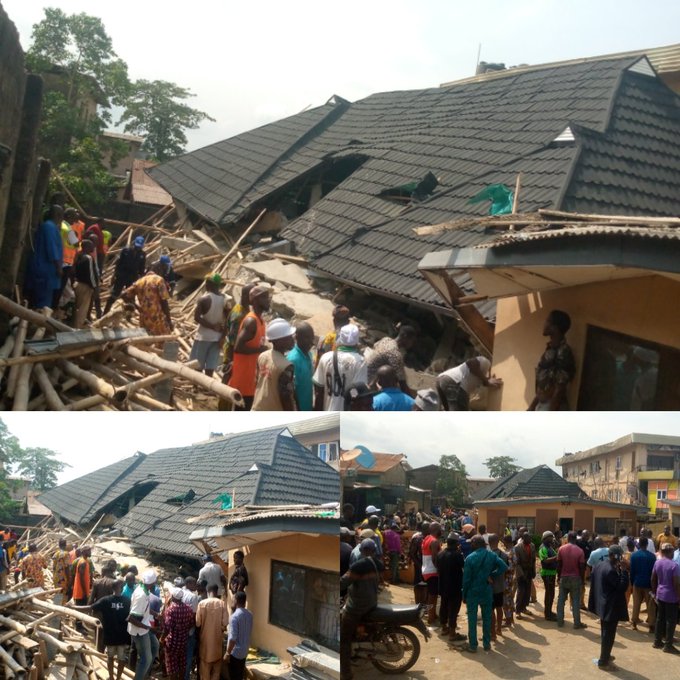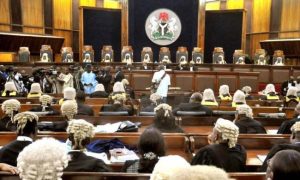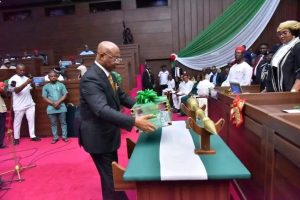Voices Under the Rubble: Many feared trapped as an uncompleted building collapses in Ikorodu (video)
A tragedy unfolded in the heart of Lagos on Monday afternoon when an uncompleted two-storey building located in the Ota-Ona area of Ikorodu collapsed, leaving a trail of devastation, fear, and unanswered questions. Eyewitness accounts, early videos, and emergency reports suggest that multiple persons were trapped under the debris, sparking fears of casualties as rescue efforts continued late into the evening.
The building, situated directly opposite the popular Mobil Filling Station—formerly known as Bugon Filling Station—crumbled without warning around 2:15 pm, according to residents and first responders.
Though five people have reportedly been pulled from the rubble alive, the fate of several others remains unknown. The collapse has once again brought to the fore urgent concerns about building integrity, regulatory enforcement, and the painful recurring trend of structural failures in Nigeria’s most populous state.
It was a quiet Monday in Ota-Ona, a bustling semi-urban neighborhood of Ikorodu, when the earth shuddered and panic erupted. Locals described hearing a deep, vibrating groan followed by a muffled boom.
“The sound was like thunder, but low and disturbing,” said Mr. Yusuf Balogun, a shopkeeper who operates across the street. “We ran out thinking it was an explosion from the filling station. That’s when we saw the dust cloud rising and people shouting, ‘e don fall! e don fall!’”
What had fallen was a concrete skeleton of a building—an uncompleted two-storey structure that had stood for months in a semi-developed state. Built with concrete pillars and iron rods protruding from the top, the structure had reportedly become a base of operations for artisans, laborers, and sometimes, squatters.
“They said some men were working there, doing plastering on the first floor,” said Balogun. “Nobody knew how many were inside. That’s why everybody panicked.”
YOU MAY READ
Tragedy Strikes Zamfara Islamic School: 17 Students Dead, 16 Injured in Devastating Fire Outbreak
The first alert came not from official channels, but from Facebook user and community activist Rasheed Fatuga, who raised the alarm on his page around 2:45 pm. Posting a shaky video and a series of photographs, Fatuga called on the Lagos State Emergency Management Agency (LASEMA), fire service, and the Nigerian Police Force to act swiftly.
“A building has collapsed just beside Mobil Filling Station in Ikorodu. Many may be trapped under the rubble. This is an emergency!” Fatuga wrote.
The video accompanying his post showed a chaotic scene: people screaming, some using bare hands to lift blocks, others standing stunned. Within minutes, the video had been shared across multiple platforms, including WhatsApp groups, X (formerly Twitter), and Instagram, prompting swift reaction from online users and influencers who tagged the Lagos State Government.
By 3:30 pm, LASEMA had confirmed that its operatives were en route to the scene.
As emergency responders arrived, including the Lagos State Fire and Rescue Service, LASEMA, the Red Cross, and officers of the Nigeria Police, a cordon was established around the collapsed structure. Trained search-and-rescue personnel began digging through the debris using shovels, crowbars, and in some cases, heavy equipment brought in later.
LASEMA’s early report indicated that five persons were rescued alive, suffering varying degrees of injuries, from broken limbs to concussions. They were immediately transported to the Ikorodu General Hospital.
However, uncertainty remained over the total number of people inside the building at the time of collapse. A site supervisor, reportedly present earlier in the day, was nowhere to be found, sparking concern that he may be among the trapped.
Dr. Femi Oke-Osanyintolu, LASEMA’s Permanent Secretary, confirmed in a press briefing at the site:
“We can confirm the partial collapse of a two-storey uncompleted structure in Ikorodu. So far, five people have been rescued alive. Our operations are ongoing with the support of other emergency services. We cannot confirm fatalities at this time.”
Eyewitnesses say that the structure had long shown signs of potential collapse. Cracks in the beams, poor scaffolding, and the use of substandard building materials were all part of the speculation.
Mrs. Adenike Adewunmi, a food vendor across the street, recounted:
“Every time we passed that building, we used to talk about how weak the pillars looked. The iron rods were rusted, and I noticed that the cement they used was not like what you see in strong buildings. It looked like they were managing things.”
According to her, the building had been under slow construction for over 18 months, with occasional work done during weekends.
“Even on Sunday, they were there. I saw at least three boys mixing cement,” she added.
Another local, a vulcanizer who simply gave his name as Bashir, said the building was sometimes used at night by young men who squatted there or stored materials.
“That’s why nobody knows how many people were inside,” Bashir said. “It was not fenced. Anybody could go in.”
Preliminary analysis by structural engineers at the site raised troubling concerns. A source who requested anonymity said the design appeared to have been compromised from the foundation level. The iron reinforcement rods were described as “below specification,” and the sand mix showed evidence of poor quality.
“The site lacked safety signage, fencing, and basic compliance documentation,” the engineer observed. “It’s doubtful if Lagos State Building Control Agency (LASBCA) approved this construction at all.”
Building collapse is not new to Lagos. In 2022, a 21-storey luxury building in Ikoyi collapsed, killing 44 people. That disaster led to a flurry of promises and inspections, but critics argue that not enough has changed.
“Every collapse is followed by outrage, then silence, then another collapse,” said human rights lawyer, Barr. Nkem Ukaegbu. “The problem is systemic negligence and regulatory compromise.”
By evening, Lagos State Governor Babajide Sanwo-Olu had been briefed. While he had not visited the site at press time, the State Commissioner for Physical Planning and Urban Development, Dr. Oluyinka Olumide, visited and ordered an immediate audit of buildings under construction in Ikorodu LGA.
“This incident is avoidable and tragic. We have directed LASBCA and relevant agencies to investigate and provide a detailed report within 72 hours,” Dr. Olumide said.
But Lagosians on social media are less forgiving.
“If LASBCA did their job, this wouldn’t have happened. Somebody should go to jail,” wrote @NaijaFixIt on X.
“How many times will people die before we fix building standards in Lagos? This is terrorism by incompetence,” added @Ada_Ikoyi.
Amid the chaos, hope flickered each time a cry was heard from beneath the rubble. Mothers wailed, friends huddled in prayer, and bystanders wept silently. For many, the collapsed building was more than failed concrete—it was failed humanity.
Mr. Jude Eze, an apprentice bricklayer who survived, recounted his escape:
“I was on the ground floor, mixing cement when I heard the noise. I looked up, and the roof was falling. I just ran. I don’t know what happened to the others. Emeka and Bayo were upstairs.”
For those whose loved ones remain unaccounted for, the waiting is agony. Mrs. Grace Akintola said her 19-year-old son had gone to the site to seek daily work.
“He left in the morning, said he would come back by evening. His phone is not ringing. I have been here since 4 pm. Nobody is telling me anything.”
According to the Building Collapse Prevention Guild (BCPG), over 152 buildings collapsed in Nigeria between 2010 and 2023. Lagos accounts for nearly 60% of these incidents. Causes range from poor design, substandard materials, lack of professional supervision, and corruption in approval processes.
Experts believe that the collapse in Ikorodu fits into this grim pattern.
“A site of this nature should have been sealed long ago. But these things continue because we don’t enforce existing laws,” said Arc. Kunle Shonibare, a member of the Nigerian Institute of Architects.
Legal analysts suggest that both the developer and the building contractor—if found culpable—could face criminal charges, including involuntary manslaughter, negligent construction, and breach of urban planning regulations.
The Lagos State Criminal Code (Section 224) allows for prosecution in cases where negligence leads to injury or death. However, convictions are rare.
As night fell on Ikorodu, floodlights from LASEMA trucks lit the site while excavators continued to dig. It was a race against time—one between life and the unforgiving weight of concrete.
For Lagos, the Ikorodu collapse is not just a news headline—it is a symptom of an enduring problem: a building culture where shortcuts trump safety, and profit trumps lives.
For the victims still under the rubble, time is running out.
Postscript:
As of 10:45 pm Monday, May 27, LASEMA confirmed that eight people had been pulled out—five alive, two dead, one unconscious. Search continues through the night.
Source: LIB





